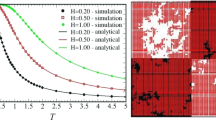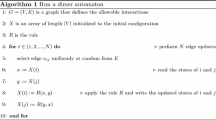Abstract
We are concerned with how the implementation of growth determines the expected number of state-changes in a growing self-organizing process. With this problem in mind, we examine two versions of the voter model on a one-dimensional growing lattice. Our main result asserts that the expected number of state-changes before an absorbing state is found can be controlled by balancing the conservative and disruptive forces of growth. This is because conservative growth preserves the self-organization of the voter model as it searches for an absorbing state, whereas disruptive growth undermines this self-organization. In particular, we focus on controlling the expected number of state-changes as the rate of growth tends to zero or infinity in the limit. These results illustrate how growth can affect the costs of self-organization and so are pertinent to the physics of growing active matter.



Similar content being viewed by others
Data availibility
Availability of data and material: not applicable
Notes
As will become apparent we could have fixed our growth rate, \(P_{g}\), and manipulated \(P_{d}\) instead. The meaningful parameter is in fact the ratio of the total decision rate and the total growth rate.
Also referred to as a nonequilibrium steady-state or fixation.
The ‘most’ disruptive form of growth is not well-defined here.
\(\beta _{c}\) can be computed efficiently by using Eq. (25) in tandem with the observation that in the limit \(P_{g} \rightarrow 0\), following any growth event \({\mathcal {C}}\) can only be in one of 2N states. From these 2N states \({\mathcal {C}}\) can only reach \(N(N+1)\) states, including the absorbing states. Therefore, K can be calculated using a matrix of \(O(N^{2})\) instead of \(O(2^{N})\). Similar reasoning applies to computing \(\beta _{c}\) for \({\mathcal {A}}\).
We now refer to the original \({\varvec{g}}\) studied as \({\varvec{g}}^{1}\).
An argument of this nature holds for any functional form of the growth greater than linear, so that \(\epsilon < O(1)\).
References
Dorogovtsev, S.N., Mendes, J.F.F.: Evolution of Networks: From Biological Nets to the Internet and WWW. OUP, Oxford (2013)
Frost, I., Smith, W. P. J., Mitri, S., San Millan, A., Davit, Y., Osborne, J. M., Pitt-Francis, J. M., MacLean, R. C., Foster, K. R.: Cooperation, competition and antibiotic resistance in bacterial colonies. ISME J. 12(6), 1582–1593 (2018)
Goldenfeld, N.: Lectures on Phase Transitions and the Renormalization Group. CRC Press, Boca Raton (2018)
Jack, R.L.: Large deviations in models of growing clusters with symmetry-breaking transitions. Phys. Rev. E 100(1), 012140 (2019)
Klymko, K., Garrahan, J.P., Whitelam, S.: Similarity of ensembles of trajectories of reversible and irreversible growth processes. Phys. Rev. E 96(4), 042126 (2017)
Liggett, T.M.: Stochastic Interacting Systems: Contact, Voter, and Exclusion Processes. Springer-Verlag, Berlin (1999)
Morris, R.G., Rogers, T.: Growth-induced breaking and unbreaking of ergodicity in fully-connected spin systems. J. Phys. A 47(34), 342003 (2014)
Mort, R.L., Ross, R.J.H., Hainey, K.J., Harrison, O., Keighren, M.A., Landini, G., Baker, R.E., Painter, K.J., Jackson, I.J., Yates, C.A.: Reconciling diverse mammalian pigmentation patterns with a fundamental mathematical model. Nat. Commun. 7, 10288 (2016)
Ortiz-Muñoz, A., Medina-Abarca, H.F., Fontana, W.: Combinatorial protein-protein interactions on a polymerizing scaffold. Proc. Natl. Acad. Sci. 117(6), 2930–2937 (2020)
Pastor-Satorras, R., Castellano, C., Van Mieghem, P., Vespignani, A.: Epidemic processes in complex networks. Rev. Mod. Phys. 87(3), 925 (2015)
Poncela, J., Gómez-Gardenes, J., Floría, L.M., Sánchez, A., Moreno, Y.: Complex cooperative networks from evolutionary preferential attachment. PLoS ONE 3(6), e2449 (2008)
Reiter, S., Hülsdunk, P., Woo, T., Lauterbach, M.A., Eberle, J.S., Akay, L.A., Longo, A., Meier-Credo, J., Kretschmer, F., Langer, J.D., Kaschube, M., Laurent, G.: Elucidating the control and development of skin patterning in cuttlefish. Nature 562(7727), 361–366 (2018)
Ross, R.J.H., Baker, R.E., Yates, C.: How domain growth is implemented determines the long term behaviour of a cell population through its effect on spatial correlations. Phys. Rev. E 94(1), 012408 (2016)
Ross, R.J.H., Strandkvist, C., Fontana, W.: Compressibility of random walker trajectories on growing networks. Phys. Lett. A 383(17), 2028–2032 (2019)
Ross, R.J.H., Strandkvist, C., Fontana, W.: A random walker’s view of networks whose growth it shapes. Phys. Rev. E 99(6), 062306 (2019)
Ross, R.J.H., Yates, C.A., Baker, R.E.: Variable species densities are induced by volume exclusion interactions upon domain growth. Phys. Rev. E 95(3), 032416 (2017)
Taylor, H.M., Karlin, S.: An Introduction to Stochastic Modeling, 3rd edn. Academic Press, New York (1984)
Author information
Authors and Affiliations
Corresponding author
Ethics declarations
Conflict of interest
The authors declare that they have no conflict of interest.
Additional information
Communicated by Sidney Redner.
Publisher's Note
Springer Nature remains neutral with regard to jurisdictional claims in published maps and institutional affiliations.
Rights and permissions
About this article
Cite this article
Ross, R.J.H., Fontana, W. Balancing Conservative and Disruptive Growth in the Voter Model. J Stat Phys 183, 15 (2021). https://doi.org/10.1007/s10955-021-02749-7
Received:
Accepted:
Published:
DOI: https://doi.org/10.1007/s10955-021-02749-7




